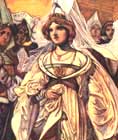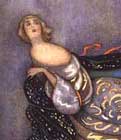
Cinderella:
345 Variants
by Marian
Roalfe Cox
SurLaLune's
Cinderella Area
SurLaLune Fairy Tales Main Page
48
Grundtvig, S., Unpublished Collection. (From Zealand.)
"HANEN OG HONEN DER GIK TIL THINGS"
(The Cock and Hen who went to the judge).
ABSTRACT
Lady wishes to be present at trial, but cannot cross bridge; promises what is carried beneath girdle, and throws bunch of keys into water. She bears son witch claims him; fetches him when grown up sets him tasks, which are performed with aid of witch's daughter. They escape from witch together. Obstacles to pursuit. Boy returns to parents; witch's daughter puts grain of oblivion in his mouth--Meeting-place (church)--Lost shoe-- Boy wants to marry owner of shoe. She is servant in his parents house Shoe marriage test-- Happy marriage.
TABULATION
(1) The hen had summoned the cock before
the judge. The lady from the hall wishes to be present to see the conclusion
of the matter, and, being unable to cross the bridge, promises to give
what she carries beneath her girdle. She therefore throws her bunch of
keys into the water, but on returning home, finds them on the table.--
(2) She bears a son, and the witch who had been under the bridge comes
to claim him, but will defer taking him till he is strong enough to work
with a pitch-fork. Then she fetches him to cleanse her stable; after that
he has to strip feathers, and, lastly, to sort grain in the loft. He is
helped over tasks by witch's daughter. He is to be fattened; puts out
a peg, a carrot, a cow's teat, instead of little finger.-- (3) The lovers
fly together; the witch, calling after them, is answered by billets in
the oven. Witch's daughter creates a sea;1
witch cannot drink it dry, and must return to fetch a bucket. Next obstacle
is a wood. Then dawn appears, and the lovers enter a churchyard, where
witch cannot get at them.-- (4) Boy goes to his parents' home, and, at
parting, witch's daughter puts a grain of oblivion into his mouth.-- (5)
Boy goes to church, where he sees a lady lose her silk shoe. He wants
to marry the person to whom shoe belongs.-- (6) An unknown girl gets a
situation as servant in his parents' house-- (7) Everybody must try the
shoe, and at last it is servant's turn. All at once she stands there in
her silk dress just as she was in church. Boy recognises her and marries
her.
[A very confused and badly-remembered tale.-Grundtvig.]
NOTES
Note 33
(P. 238.) For "obstacles" created to hinder pursuit, see also Nos. 118, 119, and cf. Am. F.-L. Journal, i, 54; iv, 19 (a Samoyede tale; see Castrèn, Ethnologische Vorlesungen, p. 65); Arnason, Icelandic Legends, p. 521; Asbjörnsen and Moe, i, p. 86, No. 14; Asiatic Researches, xx (1836), p. 347; Athanas'ev, i, No. 3b; Braga, No. 6; Brockhaus, Berichte, 1861, pp. 225-9; Busk, "Filagranata," No. i, p. 8; Callaway, Zulu Tales, pp. 51, 53, 64, 90, 145, 228; Campbell, i, lxxvii-lxxxi, xc; i, 33, No. 2, "Battle of the Birds"; Carleton, Traits and Stories of the Irish Peasantry; Cosquin, i, 133 ff.; Crane, p. 29, "The Fair Angiola" (= Gonzenbach, No. 53), and see p. 335, note; Dasent, p. 71, "The Mastermaid"; p. 285, "The Widow's Son"; p. 311, "Father Weathersky"; Erdelyi-Stier, No. 4; F.-L. Journal, i, 235 (Malagasy), 286 (Ananci), 323 (Irish tale, "Grey Norris"); ii, 15 (Polish), 31 (Malagasy); Frere, O. D. D., "Truth's Triumph", 50, 63; Friis, pp. 49, 58; Geldart, Mod. Greek Tales, "Starbright and Birdie", "The Golden Casket", 'The Scab Pate"; Germania, 1870, No. 6 (Lapp tale); Gonzenbach, Nos. 53, 64; Gottingische Gelehrte Anzeigen, 1862, p. 1228 (Finnish tale); Grimm, No. 79, "The Water-Nix"; Gubernatis, Z. M., i, 166, 175; ii, 60; Hahn, No. 1 and No. 45; Haltrich, No. 37; Imbriani, Nov. fior., pp. 12, 415; Katha Sarit Sagara, bk. vii, ch. 39; Kennedy, Fireside Stories, p. 61; Kohler, Orient and Occident, ii, 103, 107, 112, 114; Lang, Custom and Myth, pp. 88 ff., and Rev. Celt., t. iii, "Nicht Nought Nothing"; Legends of the Wigwam, p. 61, "Exploits of Grasshopper"; Leipzig Academy, 1861, bk. vii, p. 203 et seq (Sanskrit tale of Somadeva); Leskien, No. 9; Lewin (Capt.), Exercises, etc., and Popular Tales (Calcutta, 1874), p. 85; MacInnes, pp. 1 ff., 437; Magyar Folk-tales, pp. 157 ff.; Maspons, La Rondallayre, i, 41-46; Mélusine, ii, col. 214 (Samoa), 408; Memoires d l'Académie de Vienne, vol. xxiii (1874), p. 327; Naaké, Slavonic Tales, "The Wonderful Hair" and "Ivan Kruchina"; Pedroso, Port. F. Tales, "St. Peter's God-daughter"; Pentamerone, "Petrosinella", "The Flea"; Pitré, variant of No. 13 (tabulated Folk-Lore, i, 141); Radloff, iii, p. 383 (Siberian); Ralston, "The Baba Yaga", "Vasilissa the Wise, and the Water King", "The King Bear", pp. 95, 132, 140, 143, 174; Record of the Past, vol. ii, p. 142, "Tale of the Two Brothers"; Romero, Nos. 8, 38; Rink, Eskimo Tales, No. 8, "Two Girls"; Satuia ja Tarinoita, i, 142, 151; Schneller, No. 20; Theal, No. v, "Sikulume," pp. 82, 87; Thorpe, Yule-Tide Stories, pp. 223, 295, 296; Toppen, Aberglauben aus Masuren, p. 146; Trans. Asiat. Soc. of Japan, vol. x, p. 36; Vernaleken, pp. 50, 157; Webster, pp. 113-14, 120, 126.
Compare the Jason myth. To detain Aetes, Medea throws behind thc mangled remains of her own brother Apsyrtos.
In Turner's Samoa (p. 71) we read: "Members of the seaweed clan in Samoa, when they went to fight at sea, took with them some seaweed, which they threw into the sea to hinder the flight of the enemy; if the enemy tried to pick it up it sank, but rose again when any of the Seaweed clan paddled up to it. See also p. 102, ibid.
In the "Lay of Rolf Kraki" (Corpus Poet.
Bor., i, 190), Rolf, escaping from Eadgils (Adils), casts gold behind
him to delay his pursuers. This is a very common device with Cinderella.
Grimm quotes a Swiss superstition anent witches. A man, wishing to escape
from their clutches, must provide himself with something to tempt their
cupidity, and must throw it out bit by bit as he runs. The witches will
stop to pick it up (T. M., 1079).
Return to place in text.
Cox, Marian Roalfe. Cinderella: Three Hundred and Forty-five Variants of Cinderella, Catskin, and Cap O' Rushes, abstracted and tabulated. London: David Nutt for the Folklore Society, 1893.
While the original text of this book is out of copyright, the special formatting and compilation available on SurLaLune Fairy Tales is copyrighted. Be aware that while the original content has been honored, page numbering, footnote numbering, redesigned charts, links, and other aspects are unique to this site's version of the text. Use at your own risk. For private and fair use educational purposes only.
©Heidi
Anne Heiner, SurLaLune Fairy Tales
E-mail: surlalune@aol.com
Page last updated February 1, 2006
www.surlalunefairytales.com










